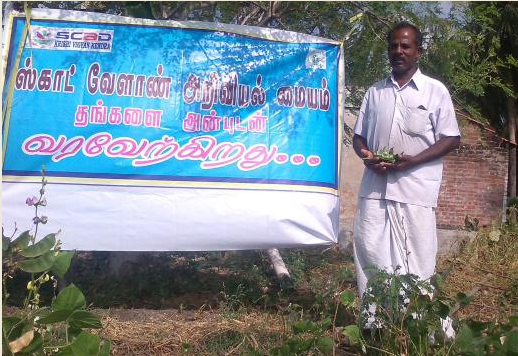| Thuthukudi farmers grow beans to overcome water shortage |
 |
|
For details please contact: |
| |
Name |
: |
Dr.G.Alagukannan |
| |
Designation |
: |
Programme Coordinator |
| |
Address |
: |
SCAD Krishi Vigyan Kendra, Mudivaithanendal Post, Vagaikulam,Thuthukudi,Tamil Nadu: 628102 |
| |
Mobile |
: |
0461-2269306 |
| |
email |
: |
pcscadkvk@gmail.com |
| |
web |
: |
www.scadkvk.org |
Thuthukudi district in Tamil Nadu is largely rainfed. Cotton, sunflower, maize, pulses, millets are some of the crops grown in the district which has predominantly black soil. Farmers are heavily dependent on the monsoon for their crops.
Prolonged drought, hot and humid conditions, high evaporation, irregular monsoon are some of the chronic problems plaguing the cultivators in the region for a long time.Farmers with bore wells and open wells seldom opt to grow crops like brinjal, chilli, tomato, banana etc. Since vegetable crops are highly sensitive to climate and temperature change. By the time they are harvested and packed to the market they shrivel because of the heat.
Preferred crops
Because of these problems, coupled with low level in the ground water table, cereals, minor millets and fodder crops are the preferred crops. Some two years back, the percentage of farmers growing vegetables had practically dropped to nil because of water scarcity, SCAD (social change and development) KVK selected 10 villages in Vilathikulam block and decided to grow Dolichos bean variety (called Avarakkai in Tamil) on a trial basis in five farmer’s fields to assess the yield potential.
The results obtained were quite encouraging and it was decided to extend the cultivation to 10 more farmers’ fields.“The variety Dolichos CO 14 is capable of producing 8-10 tonnes of green pod per hectare and the crop fetches a maximum of Rs.38 a kg and minimum of Rs.22 a kg from the local Vilathikulam market. Farmers are able to earn more than Rs.85,000 to Rs.90,000 as net income in hardly 100 days. After seeing this, more than 100 farmers have approached us for seeds.” says Dr.G.Alagukannan Programme coordinator, Vagaikulam, Thuthukudi.
Future plans
Plans are on to bring in 150-170 acres under this bean cultivation. Five farmers have been identified to produce seeds to meet the demand of the farmers.“This bean variety needs to be popularised in a larger way in areas where the farmers are having issues like less water and adverse condition in the ensuing season, “he says.
A complete package of practices is provided from the Kendra. Farmers were advised to sow seeds at 45x30cm spacing after treating it with Rhizobium solution.
First flowering
The first flowering was on the 38th day after sowing and it continues up to 80 days. About 30ml of effective micro-organism (EM) in one litre solution is to be sprayed on 45th, 60th and 75th day to boost the flower and fruit production.In addition to this three gm of “vegetable special” a crop booster was also suggested to be sprayed after diluting it in one litre on 40th, 55th and 70th days. To control the fruit borer and jassids a spray with 20 ml of neem oil in one litre with soap solution was resorted.
The crop comes to harvest on the 52nd days after sowing and one can harvest 11 times from a single crop, according to Dr.Alagukannan.Mr.Dharmaraj(52) of Kuruvarpaati village who adopted this cultivation says.
“I harvested about three tonnes of green pod from one acre. For production, I spent Rs.17,800 and earned a gross income of Rs.1,08,000. Net profit was Rs.90,000 in about 100 days. Now I have started seed production as many farmers are approaching me for seeds and technologies. I am sure that his crop will increase the income level for us in the ensuing summer months.”
All through the season
Being photo insensitive, the crop can be cultivated throughout the year with limited water and is ideal for dry lands.
TRIAL BASIS: The variety is capable of producing 8-10 tonnes of green pod per hectare
|

